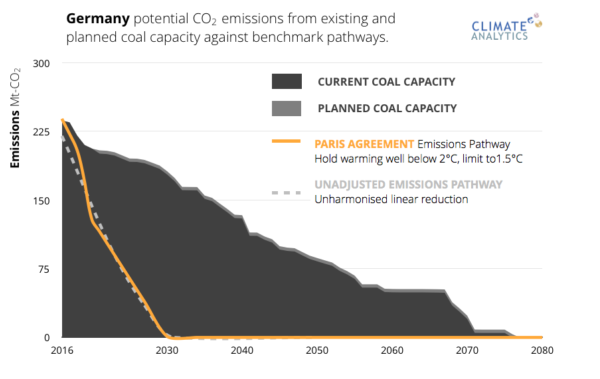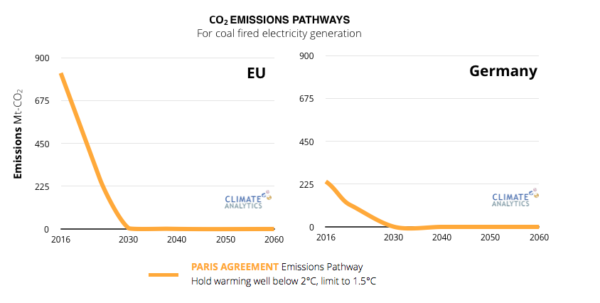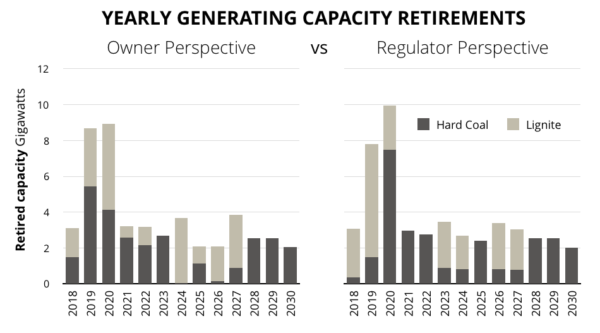Science-based coal phase-out pathway for Germany in line with the Paris Agreement 1.5°C warming limit: opportunities and benefits of an accelerated energy transition
Authors
Paola Parra, Ursula Fuentes Hutfilter, Niklas Roming, Anne Zimmer, Fabio Sferra, Tina Aboumahboub, Michiel Schaeffer, Bill Hare, Matt Beer
Share

Germany, European Union’s largest greenhouse gas emitter, has identified phasing out coal, which accounts for more than a third of its gross power production, as a key element of achieving its climate targets.
The IPCC Special Report on 1.5°C has placed renewed focus on coal. It found that phasing out coal rapidly from electricity generation globally by 2050, with very substantial reductions by 2030, is essential. This report examines for the first time what the Paris Agreement 1.5°C limit means for coal phase-out in Germany’s electricity generation.
The time is now
Establishment of the Commission on Growth, Structural Change and Employment in June 2018 (known as the Coal Commission) by the German Government has shifted the discussion from talking about the coal exit in general terms to evaluating the implications and identifying concrete pathways to carry it out. The commission is tasked with developing a coal phase-out plan to meet short-, medium- and long-term climate goals, combined with forward-looking structural development in the coal-mining regions.
With an increasingly sharp focus now on the most critical aspects of climate and energy policy decisions that need to be taken in the short term to limit warming to 1.5°C, the future of coal is now at the centre of questions as to how the world can meet the Paris Agreement’s goals. The IPCC Special Report on 1.5°C has found that it is essential to phase out coal rapidly from the power sector globally by 2050, with very substantial reductions already by 2030.
Because of the significant impact of Germanys coal-fired power plants on emissions and because of Germanys important historic lead on fighting climate change, the work of the Coal Commission is of global relevance and the phase-out date it will recommend for Germany will send a globally relevant signal.
It is in this context, and with increasing public and scientific concern over climate change and the implementation of the Paris Agreement, this study is designed as contribution to the work of the “Coal Commission” and shows a science-based coal phase-out pathway for Germany consistent with the Paris Agreement’s 1.5°C limit.
To date most analyses of coal phase-out pathways for Germany have been based on the former 2°C warming limit, first adopted by the European Union in 1996 based substantially upon the work of German scientists. Due to rising scientific and political concern over climate impacts the 2015 Paris Agreement’s long-term temperature goal called for a lower warming limit, to hold warming well below 2°C and pursue efforts to limit warming to 1.5°C above pre-industrial levels.
The Intergovernmental Panel on Climate Change (IPCC) Special Report on the 1.5°C limit has unequivocally confirmed the importance of 1.5°C as a warming limit and shown clearly that it is geophysically, technically and economically feasible to limit warming to this level. Energy and other policies to limit warming to this level are significantly different from those for 2°C in that action needs to occur significantly faster, particularly in the power sector and electrification. Now as the European Union begins to evaluate the implications of the Paris Agreement for its climate and energy policies, and with this issue central to the Commission’s consideration of phase-out pathways for Germany this report fills an important gap.
Our findings
Consistent with our previous studies, we find that coal power plant emissions need to decrease steeply in Germany in the coming years and be phased out by 2030. The delay in action until the present (2018) means steeper reductions have to be achieved by 2020 to keep within the limit of cumulative emissions in line with the Paris Agreement and at the same time close the 2020 mitigation gap.

Emissions from coal for electricity generation need to be reduced by 42% below 2017 levels by 2020 (equivalent to 60% below 1990 levels) to zero by 2030. The 2030 phase-out timeframe is much faster than the benchmarks that have been discussed so far in the Coal Commission by government officials as an appropriate contribution from coal to Germany’s mitigation targets. There is increasing recognition for the need of this phase-out date both internationally (e.g. by the Powering Past Coal Alliance) and nationally by an increasing number of recent studies and position papers.
Even with no new coal power plants coming online, to be consistent with global efforts to meet the Paris Agreement long-term temperature goal, Germany will need to implement early retirement of operating power plants and/or to reduce dramatically their utilisation rate.
The science-based Paris Agreement 1.5°C consistent coal phase-out pathway for Germany developed in this study would:
- Substantially close the 2020 emissions gap towards achieving Germany’s national target (100 MtCO2e, according to recent government estimates).
- Achieve the strong emissions reduction required by the Paris Agreement at least cost, allowing for ratcheting up of Germany’s 2030 mitigation target as envisaged in the Climate Action Plan 2050.
- Allow Germany to align its national targets with the need to scale up the EU target for 2030 in line with the Paris Agreement
- Provide stakeholders with certainty to facilitate a transition out of coal in regions where coal plays an important role.
- Avoid health impacts by halving cumulative coal related air pollution emissions from coal power generation that would otherwise have occurred to 2030 including avoiding premature deaths, hospital admissions, and asthma attacks in children as well as millions of lost working days.
Defining a plan for a structured accelerated coal phase-out, thereby bridging the emissions gap for its 2020 target, will put Germany not only in a much better position to achieve and ratchet up its 2030 targets but it will also send a positive and very important reassuring signal to other EU countries and the international community that Germany is serious about tackling the climate change problem.

The co-benefits of accelerating coal phase-out
This report presents two possible Paris Agreement compatible phase-out schedules that differ with regard to the order of unit and plant retirement. One schedule is based on the regulator’s perspective and aims to phase out plants with the highest emissions intensity first. The other schedule is based on the owner’s perspective and prioritises economic value over emissions intensity. Resulting retirement dates at the unit level are compared with other phase-out schedules put forward by different actors. Similar phase-out schedules have been shown to be achievable without hampering energy security and affordability, mainly through an accelerated investment in new renewable energy capacity.

Implementing these phase-out schedules would achieve substantial benefits of avoiding air pollution and saving health costs. More than half of the air pollutant emissions of nitrogen oxides (NOx), sulphur oxides (SOx) and primary particulate matter (PM10) as well as mercury emitted by coal power plants between 2018 and 2030 and related health impacts would be avoided. The avoided impacts from a 1.5°C compatible 2030 phase-out pathways for coal include more than 20 000 premature deaths, 9 400 hospital admissions, and 420 000 asthma attacks in children as well as around 6.7 million lost working days. Together with other avoided impacts for example on crops, this can lead to considerable cost savings.
A vast amount of recent research examines the economic and social implications of a coal phase-out. The majority of the studies reviewed here concludes that a rapid coal phase-out is not only necessary, but can also be managed in a socially just way. An analysis of published research identifies multiple opportunities and direct benefits of a structured accelerated coal phase-out:
- Save many lives and costs by reducing health damaging air pollution.
- Increase planning security for affected regions and industries
- Help to cushion the negative impacts by active planning and supporting measures as well as job creation in other more sustainable sectors.
- Help to avoid that investments continue to flow into unsustainable assets and new coal-related infrastructure, leading to carbon intensive lock-in effects and stranded assets.
- Help to avoid relocation of towns for new lignite mining (as e.g. planned for the extension of Garzweiler II) and forest clearing (e.g. the forest in Hambach).
- Create an environmentally and economically more sustainable future for the affected regions and Germany as whole, building on an accelerated transition to renewable energy.
Supplementary materials
Extended summary with graphics (English)
Extended summary with graphics (German)











